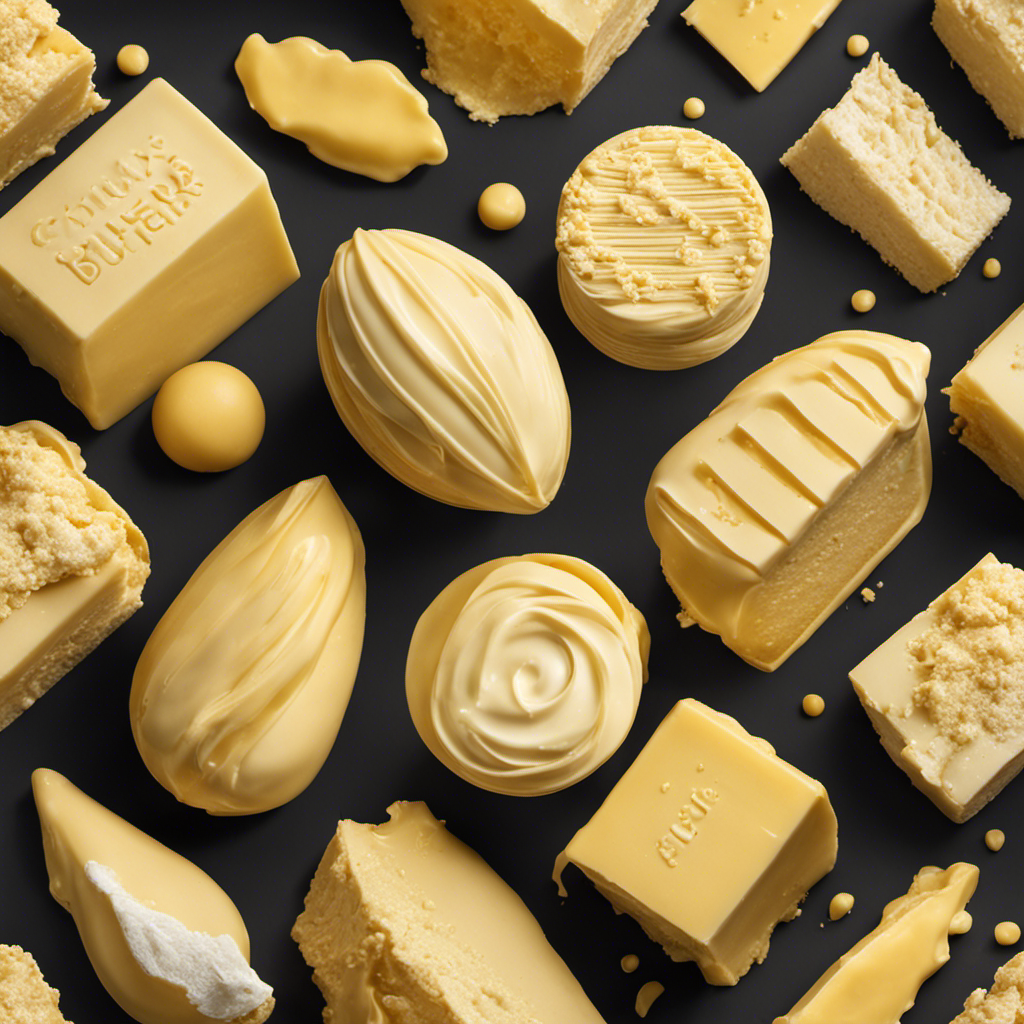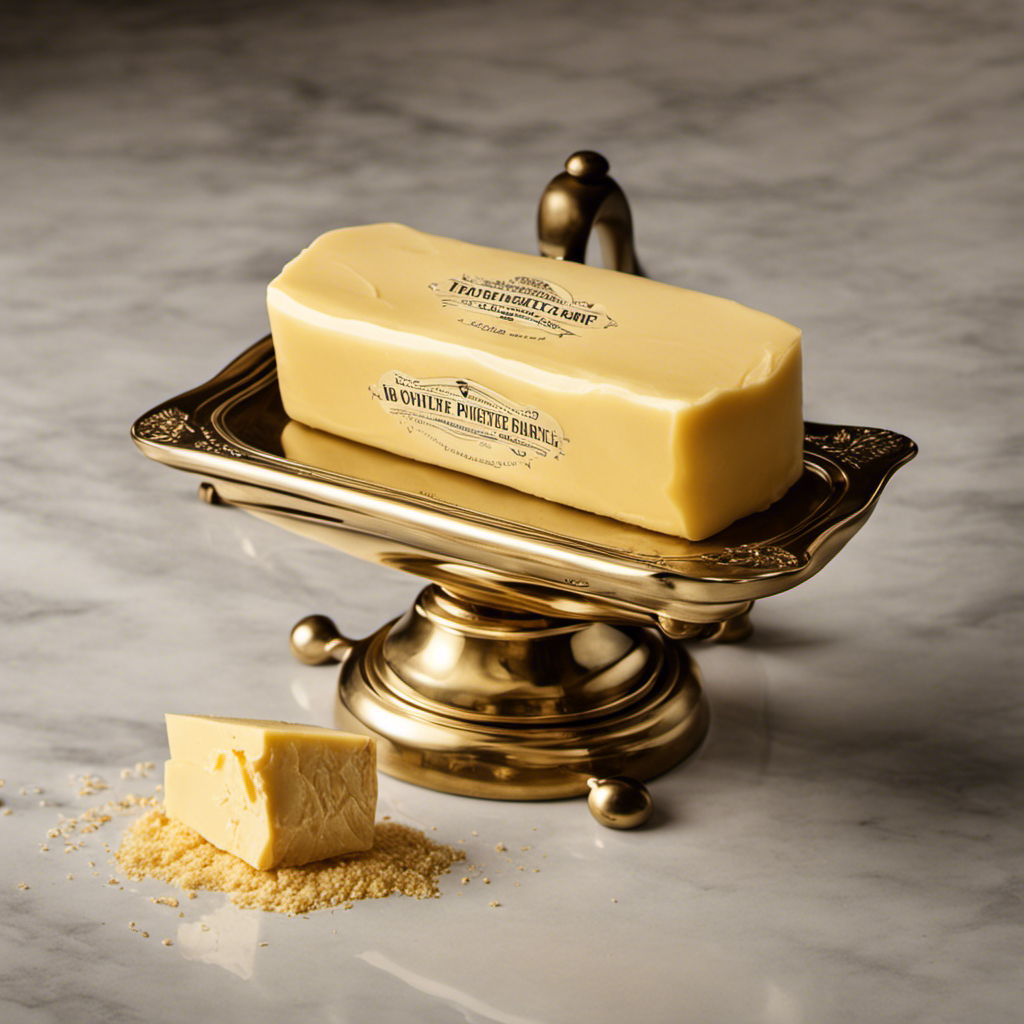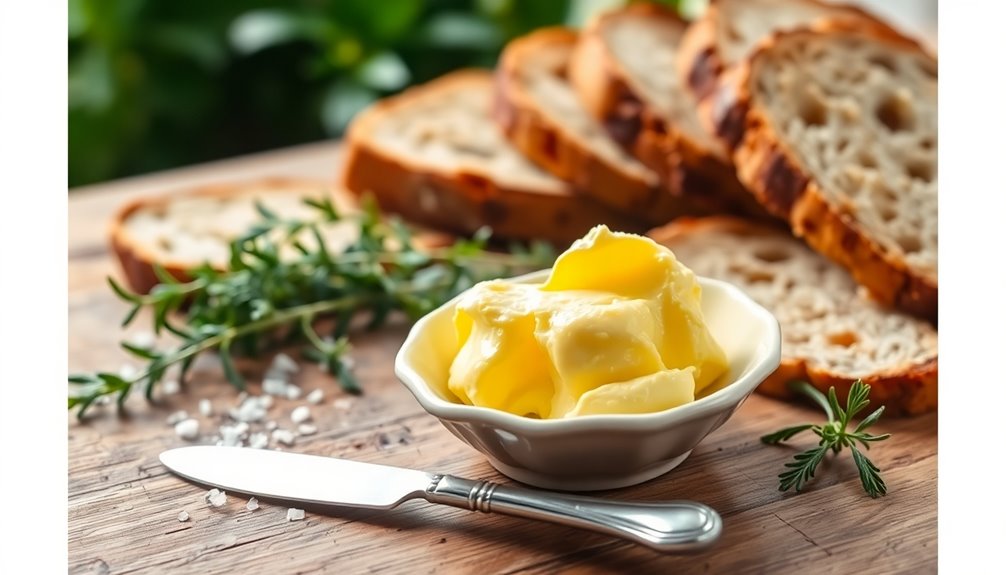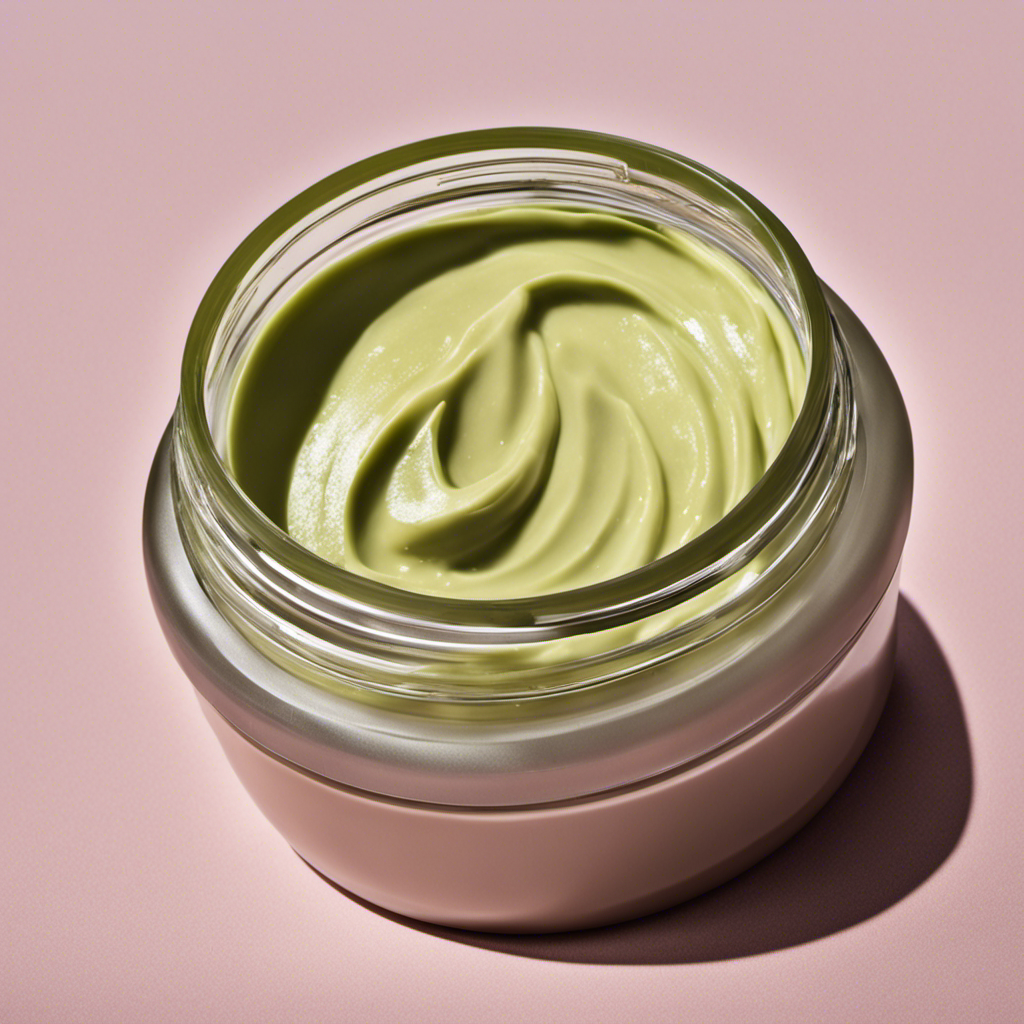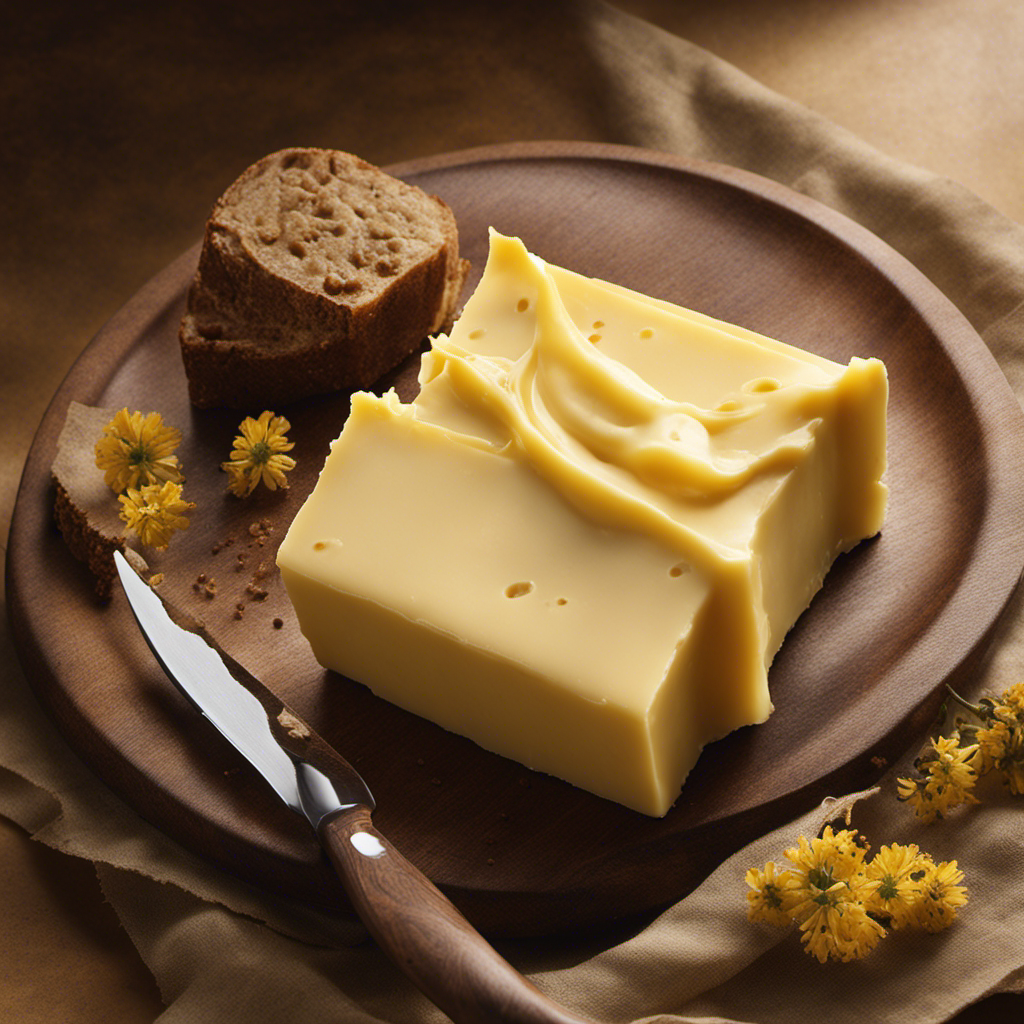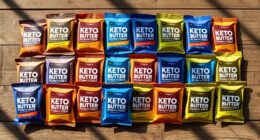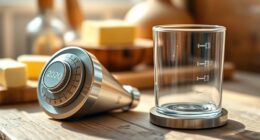I have always been fascinated by the water content in butter. Although it seems like a simple question, the answer is actually quite complex.
In this article, we’ll dive into the composition of butter, explore the factors that affect its water content, and even learn how to test the water content in different brands of butter.
Understanding the role of water in butter is crucial for ensuring its quality and shelf life. So let’s get started and uncover the truth about water in butter.
Key Takeaways
- Butter typically contains 15-20% water.
- Higher water content in butter promotes microbial growth and spoilage.
- Proper packaging and storage conditions are important for prolonging the shelf life of butter.
- Butterfat content influences water activity, with higher butterfat percentage leading to lower water activity.
Butter Composition
Butter contains a small amount of water. In the process of butter manufacturing, water is added to cream during churning to facilitate the separation of fat globules from the liquid portion.
The water content of butter is an important factor that affects its texture, spreadability, and shelf life. To ensure consistency and quality, butter manufacturers perform water content testing during production. This involves measuring the amount of water present in the butter, usually expressed as a percentage.
Accurate water content testing is essential to meet regulatory standards and maintain product integrity. Understanding the water content in butter is crucial for both producers and consumers, as it can impact the overall sensory experience and the performance of butter in various culinary applications.
Now, let’s delve deeper into the topic of water content in butter.
Water Content in Butter
The water content in butter can vary depending on its composition. Understanding the moisture content in butter is important because it affects its texture, flavor, and shelf life.
Here are three key points about butter moisture and water activity:
-
Water content: Butter typically contains about 15-20% water. This moisture is naturally present in milk fat and can vary depending on factors such as the cow’s diet and the production process.
-
Water activity: Water activity (aw) is a measure of the availability of water for microbial growth. In butter, the water activity is usually around 0.85-0.90, which is considered relatively high. This makes butter susceptible to spoilage if not stored properly.
-
Shelf life: The moisture content and water activity in butter play a crucial role in determining its shelf life. Higher moisture content and water activity can promote microbial growth and accelerate spoilage. Proper packaging and storage conditions, such as refrigeration, can help prolong the shelf life of butter.
Understanding the moisture content and water activity in butter is essential for maintaining its quality and ensuring food safety.
Factors Affecting Water Content
When examining the factors that influence the water content in butter, it’s crucial to consider the impact of processing methods, storage conditions, and butterfat content.
The processing methods employed during butter production can significantly affect the amount of water retained in the final product.
Similarly, the storage conditions in which butter is kept can have a notable influence on its water content.
Furthermore, the butterfat content itself plays a crucial role in determining the amount of water present in the butter.
Understanding these factors is essential for ensuring the quality and consistency of butter.
Processing Methods Impact Water
You might be surprised by how much water is impacted by different processing methods. When it comes to butter production, processing techniques play a crucial role in determining the water content. Here are three ways in which processing methods affect water activity:
-
Churning: During the churning process, cream is agitated to separate the butterfat from the buttermilk. This separation increases the water activity in butter as the water is released from the cream.
-
Washing: After churning, butter is often washed to remove any remaining buttermilk. This washing step helps reduce the water activity by removing excess water from the butter.
-
Packaging: The packaging method also influences the water activity in butter. Proper packaging can help maintain the desired water content by preventing moisture loss or absorption.
Understanding how processing methods impact water activity in butter is essential for quality control and ensuring the desired texture and shelf life.
Storage Conditions Affect Water
Storing butter in different conditions can have a significant impact on its water activity. The impact of temperature and packaging methods on butter’s water content cannot be overstated.
Temperature fluctuations can cause the butter to melt or solidify, affecting its water activity. At higher temperatures, the water content in butter may increase due to the melting of fat globules. Conversely, lower temperatures can cause the water to freeze, resulting in a decrease in water activity.
Packaging methods also play a crucial role in maintaining the water content of butter. Properly sealed packaging can prevent moisture loss, while inadequate packaging can lead to water evaporation and, consequently, a decrease in water activity.
Therefore, controlling temperature and using appropriate packaging methods are essential for preserving the desired water activity in butter.
Butterfat Content Affects Water
In my previous subtopic, I discussed how storage conditions can affect the water content in butter. Now, let’s shift our focus to another important factor that influences the water in butter: the butterfat percentage.
Here are three key points to understand the relationship between butterfat percentage and water activity:
-
Butterfat is the lipid component of butter, and it plays a crucial role in determining the water activity, which is a measure of the availability of water for microbial growth.
-
A higher butterfat percentage leads to lower water activity in butter. This is because the fat molecules create a physical barrier that restricts the movement of water molecules.
-
Lower water activity in butter helps to extend its shelf life by inhibiting the growth of spoilage microorganisms.
Understanding the impact of butterfat percentage on water activity is essential for maintaining the quality and safety of butter during storage and distribution.
Testing Water Content in Butter
To test the water content in butter, start by melting a sample and observing for any signs of separation. If water is present, it will separate from the fat and form distinct layers. Another method is the Karl Fischer titration, which involves adding specific reagents to the butter sample to determine the water content. This method provides accurate results but requires specialized equipment. Analyzing the results can be done by comparing the water content of different butter samples or tracking changes in water content over time. For a better understanding, refer to the table below:
| Butter Sample | Water Content (%) |
|---|---|
| Brand A | 15.2 |
| Brand B | 12.8 |
| Brand C | 17.6 |
Variations in Water Content Among Butter Brands
By comparing the water content percentages of different brands, you can gain insights into the variations among butter brands. The amount of water in butter plays a crucial role in its texture, taste, and overall quality.
Here are three key points about the variation in water content among different butter brands:
-
Water content affects consistency: Butter with higher water content tends to be softer and more spreadable, while butter with lower water content is firmer and holds its shape better.
-
Water content influences flavor: Water dilutes the flavor of butter, so higher water content may result in a milder taste, while lower water content can contribute to a richer, creamier flavor.
-
Water content affects shelf life: Butter with higher water content is more susceptible to spoilage, as water promotes the growth of bacteria. On the other hand, lower water content helps extend the shelf life of butter.
Understanding the variation in water content among different butter brands is essential for choosing the right butter for your culinary needs.
Impact of Water Content on Butter Quality
Water content plays a crucial role in determining the texture of butter. A higher water content can result in a softer and more spreadable texture, while a lower water content can make the butter firmer and harder to spread. Understanding the relationship between water content and texture is essential in producing butter with the desired consistency and mouthfeel.
Additionally, water content also affects the preservation of butter, as higher water content can promote microbial growth and reduce the shelf life of the product. Therefore, proper control and management of water content are important considerations in ensuring the quality and longevity of butter.
Water Content and Texture
You’ll notice that the water content in butter greatly affects its texture. It is important to understand the impact of water content on butter quality, especially when it comes to baking.
Here are three key points to consider:
-
Water content and taste: The amount of water in butter directly affects its taste. Higher water content can result in a more diluted flavor, while lower water content can intensify the buttery taste.
-
Impact of water content on baking: Water content plays a crucial role in baking. Butter with high water content can make baked goods more moist and tender, but it can also lead to a denser texture. On the other hand, butter with lower water content can produce flakier pastries and a lighter texture.
-
Finding the right balance: Achieving the perfect texture in baked goods requires finding the right balance of water content in butter. It is essential to consider the desired outcome and adjust the water content accordingly to achieve the best results.
Understanding the relationship between water content and texture in butter is key to achieving the desired results in baking.
Water Content and Preservation
Preserving the quality of butter relies on finding the right balance of moisture content. Water content measurement is crucial in determining the freshness and shelf life of butter.
Too much moisture can lead to spoilage, while too little can result in a dry and unpalatable product. The effects of water on butter flavor are also significant. Excess water can dilute the natural flavors, making the butter taste bland. On the other hand, a lack of moisture can cause the butter to have a rancid or off-flavor.
Therefore, precise control of water content is essential in ensuring the desired flavor profile of butter. By accurately measuring and maintaining the correct moisture levels, producers can guarantee the preservation of butter’s quality and taste.
Shelf Life and Water Content in Butter
To maintain freshness, it’s important to be mindful of the water content in your butter. The water activity in butter plays a crucial role in determining its shelf life.
Here’s how water content affects butter:
-
Shelf life: High water content in butter can reduce its shelf life by promoting microbial growth. Bacteria and molds thrive in moist environments, leading to spoilage.
-
Spreadability: Water content affects the spreadability of butter. Higher water content results in softer butter that is easier to spread, while lower water content makes it harder and less spreadable.
-
Texture and flavor: Water content also influences the texture and flavor of butter. Too much water can make butter greasy, while too little can make it dry and crumbly.
Controlling water content in homemade butter is essential for maintaining its quality and freshness. Now, let’s explore some tips to help you achieve the desired water content in your homemade butter.
Tips for Controlling Water Content in Homemade Butter
When making your own butter at home, it’s important to control the amount of water to achieve the desired consistency and freshness.
Controlling moisture in homemade butter is crucial for its quality and shelf life. Here are some tips to help you achieve the perfect water content in your butter.
First, start with high-quality cream that has a low water content. This will ensure that your butter has less moisture to begin with.
Second, make sure to properly drain and press the butter after churning. This will help remove any excess water.
Finally, store your homemade butter in an airtight container to prevent moisture absorption from the surroundings.
Frequently Asked Questions
Can Water Content in Butter Affect Its Texture and Consistency?
The water content in butter can definitely affect its texture and consistency. Higher water content can make butter softer and spreadable, while lower water content can make it harder and more firm. Additionally, the water content can impact the butter’s melting point.
How Does the Water Content in Butter Affect Its Shelf Life?
The water content in butter affects its shelf life. Higher water content can lead to bacterial growth, shortening the shelf life. Additionally, water affects the flavor and spreadability of butter, making it essential to control water content for optimal quality.
Are There Any Tips for Reducing Water Content in Homemade Butter?
Reducing water content in homemade butter is essential for better butter preservation. To achieve this, one can use a technique called washing, which involves rinsing the butter multiple times with cold water to remove excess water.
Is There a Standardized Method for Testing Water Content in Butter?
There isn’t a standardized method for testing water content in butter. However, I can provide you with tips on reducing water content in homemade butter. Let’s focus on that!
What Are Some Common Factors That Can Cause Variations in Water Content Among Different Brands of Butter?
Factors affecting water content in butter include the production method, cream quality, and storage conditions. Water content is crucial for baking as it affects texture, moisture, and overall quality of baked goods.
Conclusion
In conclusion, butter is composed of various components, including water. The water content in butter can vary depending on factors such as production methods and storage conditions.
Testing water content in butter is crucial in ensuring its quality. Different brands may have variations in water content, which can affect the overall taste and texture of the butter.
Moreover, the water content in butter plays a significant role in determining its shelf life. Therefore, it is essential to control water content when making homemade butter to achieve the desired consistency and longevity.
As they say, "Water content in butter is the lifeblood that determines its destiny."
